|
|
 |
History | Raffles Arrival
|
|
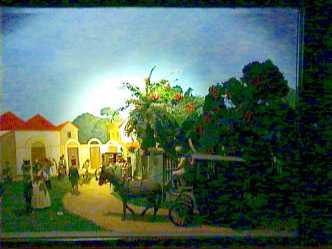 During the second half of the 18th century, the trade of British
with China was expanding at that time. Therefore there was a need for them to
set up a port in the region to refit, revitalize and protect their merchant
fleet as well as to forestall any attacks of the Dutch from East Indies. As a
result, trading posts were established in Penang in 1786 and Singapore in 1819.
Malacca was also captured from the Dutch in 1795.
During the second half of the 18th century, the trade of British
with China was expanding at that time. Therefore there was a need for them to
set up a port in the region to refit, revitalize and protect their merchant
fleet as well as to forestall any attacks of the Dutch from East Indies. As a
result, trading posts were established in Penang in 1786 and Singapore in 1819.
Malacca was also captured from the Dutch in 1795.
During the late 1818, Lord Hastings, who was the
Governor-General of India, gave approval to Sir Stamford Raffles, the
Lieutenant-Governor of Bencoolen to set up a trading station at the southern tip
of the Malay Peninsula. On 29th of January 1819, Sir Stamford Raffles
set foot on Singapore after surveying other nearby island. The very next day,
he concluded a preliminary treaty with Temenggong Abdu’r Rahman to set up a
trading post here.
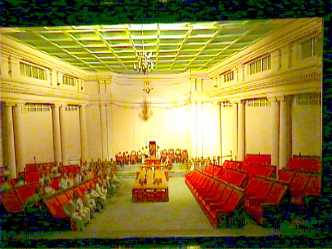
On the 6th of February 1819, Sir Stamford Raffles concluded a formal treaty
with Sultan Hussein of Johor and the Temenggong. Singapore proved to be a
prized settlement and by 1820, it was already earning revenue. Three years
later, the revenue from the trade generated surpassed that of Penang.
In 1824, Singapore’s status as a British possession was officially declared
with the signing of two treaties. The first treaty was for the Dutch to withdraw
all objections to the British occupation of Singapore. This is known as the
Anglo-Dutch Treaty, which was signed in March. The other treaty established
concerns Sultan Hussein and the Temenggong for them to give up the rights of
Singapore to the British in return for increased cash payments and pensions.
Two years after signing the treaty, Singapore, together with Malacca and Penang,
formed the Straits Settlement, under the control of British India. By 1832,
Singapore had become the centre of government for the Straits Settlement. On the
1st of April 1867, the Straits Settlement became a Crown Colony under
the jurisdiction of the Colonial Office in London.
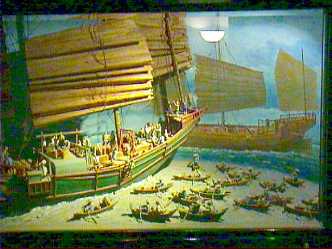 With the arrival of steamships in the mid 1860s and the opening of the Suez
Canal in 1869, Singapore became a major port of call for ships travelling
between Europe and East Asia. With the development of rubber after the 1870s,
Singapore became the main sorting and exporting centre for rubber in the world.
With the arrival of steamships in the mid 1860s and the opening of the Suez
Canal in 1869, Singapore became a major port of call for ships travelling
between Europe and East Asia. With the development of rubber after the 1870s,
Singapore became the main sorting and exporting centre for rubber in the world.
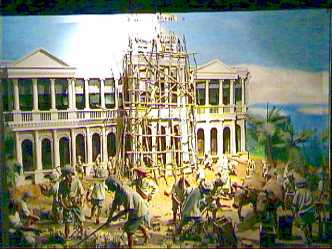 Raffles also planed to set up a commercial centre, the present day Shenton Way,
and constructing government buildings around Fort Canning. Raffles, along with
the first Resident of Singapore, William Farquhar moulded Singapore from a
jungle-ridden backwater with poor sanitation and little infrastructure to a
successful entreport and colonial outpost. Hospitals, schools and a water supply
system were also built. Soon after the building, many immigrants from India and
China were coming to Singapore to earn a living and a better life.) The arrival
of the immigrants increased the population of Singapore.
Raffles also planed to set up a commercial centre, the present day Shenton Way,
and constructing government buildings around Fort Canning. Raffles, along with
the first Resident of Singapore, William Farquhar moulded Singapore from a
jungle-ridden backwater with poor sanitation and little infrastructure to a
successful entreport and colonial outpost. Hospitals, schools and a water supply
system were also built. Soon after the building, many immigrants from India and
China were coming to Singapore to earn a living and a better life.) The arrival
of the immigrants increased the population of Singapore.
In the present day, Raffles name is linked to a boulevard, a school, a college,
a hotel, a shopping mall, the business class of Singapore Airlines, a golf club
and a lighthouse out of a certain respect and act as a sense of history.
|
1819 - 1945 Colonial Period
|
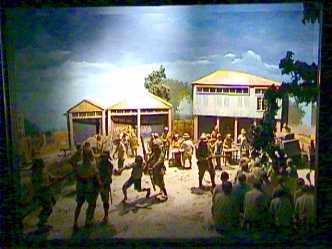
|
This period saw Singapore under British rule, the
fall of our country into Japanese hands during World War II, the fight put up by our resistance fighters, and the disillusionment of our forefathers when the British returned to rule them.
|
Colonial Period - Movie
Description
and Movie - Courtesy of Government of Singapore (Singapore
Infomap)
|
|
Back to the Past
|
To the next era
|
|
|
|
|